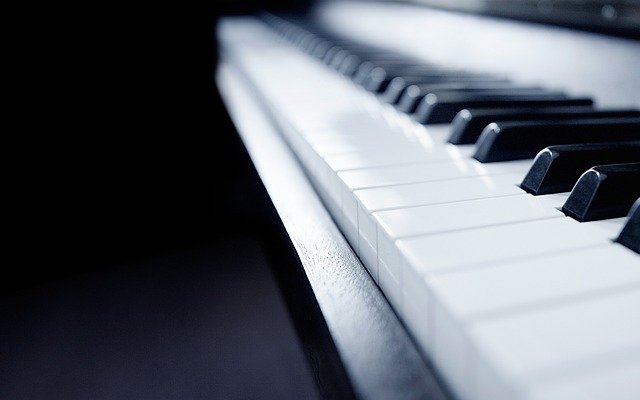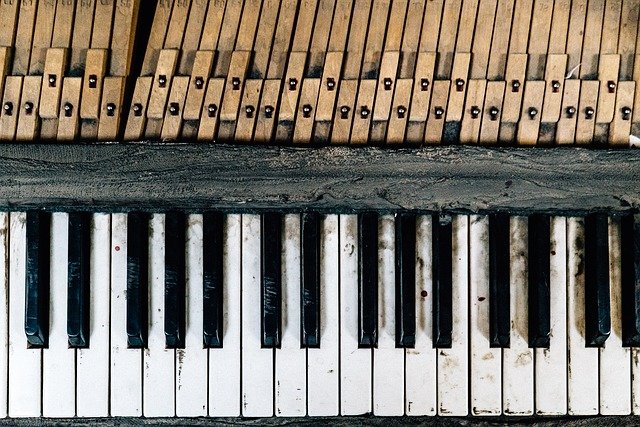You can paint a piano if you don’t like the color of yours! A piano can be painted in a few hours to become a work of art. I’ll demonstrate how to update the piano without moving it and avoid sanding to produce a piece you love.
First, how to paint a piano?
Generally, you can take three steps. Clean & prime your piano, apply coats of paint, and wax & dry your piano.
For step-by-step instructions on painting a piano, continue reading.
Table of Contents
Supplies For Painting A Piano
To paint a piano, you will need the following:
- One gallon latex paint, satin finish (I used BEHR Ultra Paint & Primer in One in Dayflower)
- Graco TrueCoat 360 Paint Sprayer*
- Paint brush(es)
- Painter’s tape (1-2 rolls, depending on how much needs to be taped on your piano)
- Plastic sheeting (for covering inside of piano)
- 400 grit & 80 grit sandpaper
*Note: You don’t need a paint sprayer to do this project, you can paint the piano by hand, but the sprayer makes for a quicker paint job and a smoother finish! Cover the area you are working in with a paint sprayer in order to prevent overspray. Extra plastic sheeting was utilized.
Clean & Prime Your Piano
Use rags, soap, and water to clean your piano. Use a wet cloth to gently rub your soapy solution along the piano’s surface after filling a small bowl with it. Once finished, use a dry rag to clean the piano. Don’t forget to clean the forgotten crevices.
Painter’s tape strips can be used to protect piano keys. To completely cover the piano keys, place horizontal painter’s tape strips across the keys. To shield the keys from errant paint drops, you can tape a rectangle of plastic to them. If you can’t remove the piano pedals, you can tape plastic around them instead.
Cover the piano’s internal components with drop cloths and the area around it. Open the piano and cover the interior with a drop cloth. Ensure that plastic is used to completely enclose the interior. To hold the drop cloth in place, use painter’s tape strips.
Put drop cloths on the floor around and beneath the piano. You can also attach tarps to any nearby walls if you’re painting the piano indoors. To lessen the possibility of unintentionally painting your walls or floors, move your piano to a garage space if you can.
To remove the high gloss finish from your piano, use fine-grit sandpaper. Use a piece of sandpaper to gently rub away any remaining high gloss finish from the piano. Use a medium-grade sandpaper with a fine grit, such as 100. After sanding, wipe the surface with a dry cloth to completely remove all of the sanding dust.
Your piano should be primed. Pick up one big can of primer. Apply a uniform coat of primer to the piano’s surface with your wide paintbrush. If you have any helpers, grab another brush or two so that several people can quickly paint the piano by tackling different sections one at a time. A minimum of an hour will pass while you wait for the primer to dry. Put the primer away and wash your brushes in the interim. See more about How To Decorate A Piano Top To Fit Any Style
Apply Coats Of Paint
Select two or three large cans of the paint of your choice. A matte or eggshell paint should be used for a matte piano. Use a gloss paint to make your piano more shiny and gloss. Choose a semi gloss if you want your piano to be at a good balance between being neither too shiny nor too matte.
Apply even brushstrokes to your piano using your wide brush. Another task that a small group can complete is this one: if you have multiple people and brushes, assign everyone a section to paint. Use your small brush for this fine detail work if you need to get into tight spaces that are challenging to paint with a larger brush. Wait for the first coat to dry after finishing it.
As soon as you’re satisfied with the outcome, add additional coats of paint. The quantity of coats required may change depending on the paint you select. Consider using at least two coats.
Await the piano’s drying out. Your piano needs to be dry before waxing. If possible, leave it to dry overnight. If your piano is outside, bring it inside or make sure it is weatherproofed.
Wax & Dry Your Piano
With a firm buffing motion, apply wax to your piano. Make use of a clean, lint-free rag or a wax brush. Apply the wax to the piano using circular, “buffing,” motions after dipping your brush or rag into the can. While applying the wax, press firmly onto the surface. Use your elbow grease without hesitation!
To stop wax from clumping, remove excess wax. Reapply the wax to your piano and wipe off any extra with a lint-free cloth to avoid clumps forming. Be sure to move quickly so that wax clumps don’t harden before you have a chance to smooth them out! You’re almost done once you’ve waxed your piano.
Hold off until the piano is dry. You can wash your brushes and put away your extra paint and wax cans while your piano dries.
Dismantle the workspace, then play the piano for yourself. Take off all the plastic and painter’s tape from your piano. You can now display your updated, DIY painted piano!

Where Do You Use Paint On A Piano?
You can choose from a wide variety of paints for pianos. Given that it requires less sanding, chalk paint is popular.
I chose a Behr paint in a satin finish because I wanted to use a standard latex paint because there were more color options. Built-in primer, which performed flawlessly. I like that I didn’t have to prime it before using it. See more about How To Paint A Pergola
How Much Does Paint An Orchestra Cost?
Are you curious about the project’s budget? Below, I’ve broken it down, including how much I paid for our used piano.
- 2nd hand piano – $150
- 1 gallon paint – $38.98
- Paintbrush – $11.97
- Painter’s tape – $9.38
- 80 grit sandpaper – $4.97
- 400 grit sandpaper – $4.97
The piano itself was part of the project’s total cost, which was as follows: $220.27. If you were also investing in a brand-new paint sprayer (approximately $250) for this project, that would drive the cost up to $470.27. See more about Can You Spray Paint Faucets?
FAQs About Painting A Piano
How Can An Outdated Piano Be Updated?
Paint it!
What Sort Of Paint Do You Use To Decorate A Piano?
The same paint you like to use on furniture can be used to paint a piano: we prefer chalk paint or plain old latex. However, latex or perhaps chalk if we have it on hand are our go-to paints. Milk paint and spray paint also work.
What Do You Use To Enclose Your Piano?
Mixwax Polycrylic is our go-to sealant. It leaves a smooth finish and does not yellow.
We wax it to seal it after chalk painting. It leaves behind a smooth, buttery finish. Note that since wax breaks down after two years, you should re-wax your furniture every 18 months. Before deciding between chalk paint and latex paint, keep that in mind even though it’s not a huge deal-breaker.
How Much Does It Cost To Paint A Piano?
Your piano would cost thousands of dollars to have professionally refinished. Since we were using leftover paint from the construction of our miniature library, painting this was free. For the price of the paint, you could DIY a piano!
Can You Do The Piano’s Own Refinishing?
Of the many methods for painting furniture, we chose to use a basic brush and latex paint. Don’t forget your confidence!
Can You Paint Piano Keys?
Yes, you should tape off the keys and pedals before painting your piano. Sand between coats before painting. Choose your favorite, the brightest color, and start painting. Use a foam brush to smooth the paint.
The Bottom Line
That big, brown, “I’m doing nothing for you” piece of furniture that is sucking the style out of your living room is the old piano, it screams in the background. Consider how amazing it would be if you changed the boring brown color to something vibrant like yellow, emerald green, or even teal. Even though it appears to be a good decoration piece with its doily and all!
Last but not least, I want to thank you for reading.


